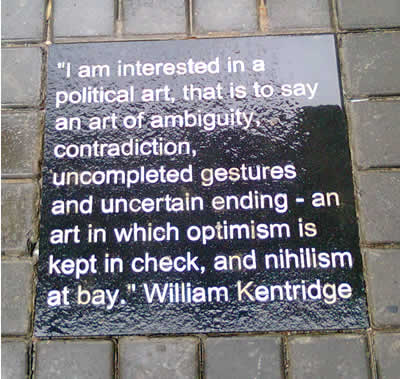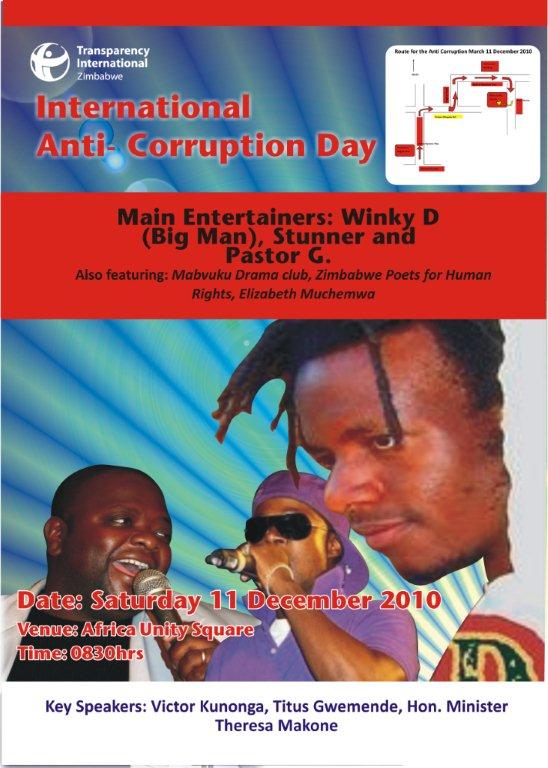Archive for the 'Inspiration' Category
2011: What will YOU make of it?
Wednesday, January 5th, 2011 by Amanda AtwoodHappy New Year!
What is your resolution about how you’ll get involved in making change happen in 2011?
Comment back, or email info[at] kubatana [dot] net
Come to the Rokpa Trust film screening & talk
Wednesday, January 5th, 2011 by Amanda AtwoodRokpa Trust Zimbabwe presents ‘The Cup’ with a talk by Rob Nairn on ‘Living Joyfully.’
Friday 14th January 2011 from 5.30pm – 8.30pm at St. George’s College Lecture Theatre (near the school church), Borrowdale Road. Movie starts at 7pm.
Entrance fee: USD10
The first evening in a planned monthly event, includes guest speaker Rob Nairn, internationally sought-after teacher on Buddhism and meditation, followed by drinks and snacks and an award winning feature film for all ages by Khyentse Norbu, a prominent Tibetan Buddhist – ‘The Cup’ : World Cup fever sweeps into a remote Himalayan monastery and centuries – old traditions are threatened – the young monks will do just about anything to watch the final match, posing a unique challenge to the venerable lamas in charge. This breakthrough debut feature film is filmed on location – with Buddhist monk actors – at Chokling Monastery, India.
94 mins, Tibetan with English subtitles.
Rob Nairn is an excellent speaker and the film is a joy to watch. A time to be inspired, entertained and an excuse to socialize. An evening not to be missed!
For more information contact Rokpa Trust at rokpa [at] zol [dot] co [dot] zw or phone Amina Zuarica at +263 4 304202
There’s no substitute for just going on, patiently, doing it properly
Thursday, December 9th, 2010 by Bev ClarkMonica Glenshaw District medical officer for Buhera, Zimbabwe: The Lancet publishes an obituary
Monica Glenshaw District medical officer for Buhera, Zimbabwe. Born on Nov 16, 1941, in Van Dyk, South Africa, she died from breast cancer in Harare, Zimbabwe, on Sept 20, 2010, aged 68 years.
Monica Glenshaw, growing up in the white enclave of a South African gold-mining village, had no idea that 90% of black Africans lived in dire poverty. But exposed as a student to the realities of life in Soweto by a Catholic women’s group that ran sewing classes in the township, her life began to take a different direction. “I knew I had a debt to pay”, she told friends a great deal later.
Recognising the immense need around her, Glenshaw embarked on medical studies and a path that took her eventually, in 1985, to Murambinda Hospital in Buhera, one of the poorest provinces in Zimbabwe, where she became medical superintendent and then district medical officer as well. For 25 years she dedicated herself to saving lives and improving the health care of the people of the region while pioneering programmes for HIV care in Murambinda that were later rolled out across Zimbabwe. Murambinda became a model for rural health care, in defiance of restricted funds and a tense political situation.
“She really was a very impressive person and I am sure the community in Buhera will miss her terribly. She will be impossible to replace”, said Professor David Sanders, director of the public health programme at the University the Western Cape, adding that “DMOs like her are perhaps the most skilled of all medical practitioners and far too little importance is accorded to training and supporting such people.”
Glenshaw set herself to improve the standards of care across Buhera, installing running water in outlying clinics and using World Bank funds offered for upgrading one hospital in each province to improve both Murambinda and Birchenough Bridge as well. At Murambinda, which she ran in close partnership with matron Sister Barbara Armstrong of the Little Company of Mary, she introduced a nurses’ training school, which now makes a substantial contribution to the training of nurses in Zimbabwe.
In the early 1990s, with no treatment for patients with AIDS, both hospitals developed home-based care programmes under Glenshaw’s guidance. In 2001, she introduced a pioneering programme to prevent mother-to-child transmission of HIV, run by a young physician colleague, Anna Miller, and with support from the University of Bordeaux in France and the Elizabeth Glaser Paediatric AIDS Foundation in the USA. “The programme proved that prevention could succeed in a resource poor setting in rural Africa-something which had previously been in doubt in academic health circles”, wrote Miller. Glenshaw also forged partnerships with Médecins Sans Frontières and TB Alert. “There is nothing heroic in treating TB”, said Glenshaw. “But we can cure it, and although 50% of the TB patients we see are HIV-positive you can make a real difference to their lives. Un-combated, TB will accelerate the devastation of the AIDS epidemic. But you can treat it. There’s no substitute for just going on, patiently, doggedly, doing it properly.”
Glenshaw was the third child of a gold assayer and his wife. She had wanted to become a vet, but her school grades were not good enough, so she did a 2-year diploma in agricultural studies. Her brother Peter told her she could do something better with her life and introduced her to a Catholic women’s organisation called The Grail in Johannesburg, which opened her eyes to the sufferings of the black majority in her country. She took a BSc in chemistry and botany and then enrolled in the University of Witwatersrand to study medicine, where she was about 10 years older than the rest of her class. Glenshaw was clear about her destiny, choosing to do her electives not in prestigious white hospitals but in Baragwanath in Soweto, and at both Hlabisa and Nqutu in KwaZulu Natal. After a first job in Nqutu, she went to work in Zambia for some years, appalled by South African apartheid. She returned to South Africa in 1979 but left 2 years later for a job with Oxfam in Mutare, Zimbabwe.
By 1985, when she applied for the job at Murambinda, she was ready to settle for good. “A whole section of your brain rests”, she said. “All the questions of ‘What am I going to do next?’ are quietened and you can think of other things.” Glenshaw was a dedicated doctor, but her friends also talk of her zest for life-her love of the arts and literature and gardening but also of a party, a drink, and her Jack Russell pup, Nutu, from whom she was inseparable.
Sarah Boseley
And in Harare, the late Dr Glenshaw is given the Lynde Francis Award:
The United States Government, through the U.S. Agency for International Development (USAID), will host the 10th annual Auxillia Chimusoro Awards Ceremony in Zimbabwe. The Auxillia Chimusoro awards honor individuals or organizations that have excelled in their involvement in the fight against HIV and AIDS in Zimbabwe. The awards are given to individuals who have demonstrated substantial contributions in communication, leadership, social investment and any outstanding works that have made a remarkable impact in Zimbabwean society in mitigating the effects and impact of HIV and AIDS.
The awards are named after Auxillia Chimusoro, one of the first individuals to disclose their HIV positive status in Zimbabwe. In spite of the significant social stigma attached to HIV and AIDS at that time, Chimusoro publicly disclosed her HIV positive status in 1989 to promote greater awareness and to help change behaviors that increase the risk of infection. Auxillia founded Batanai HIV/AIDS Support Group in 1992 and was one of the founders of the Zimbabwe National Network of People Living with HIV/AIDS. She also worked with several support groups before her death in June 1998.
This year, a new award category has been added in honor of Lynde Francis, a tireless HIV/AIDS advocate who recently succumbed to the disease. The Lynde Francis award is given to a deserving individual or institution whose actions have made a remarkable impact on the course of the epidemic in Zimbabwe.
The first recipient of the Lynde Francis award is the late Dr. Monica Glenshaw, former District Medical Officer for Manicaland and Superintendent of Murambinda Hospital for 30 years. The winner of the Communication Award is Catherine Murombedzi, the first journalist in Zimbabwe to publicly reveal her positive status. Dr. Owen Mugurungi of the Ministry of Health and Child Welfare won the Leadership award in recognition of his outstanding leadership within the national programme to fight HIV/AIDS. The winner of the Social Investment Award is Africaid, which runs the Zvandiri HIV Programme for adolescents.
Since 2000, the United States government has invested over $245 million in Zimbabwe’s fight against HIV/AIDS. U.S. plans for HIV/AIDS assistance to Zimbabwe calls for an increase of $10 million in 2011, bringing the total annual U.S. investment in fighting HIV/AIDS in Zimbabwe to around $57 million. Part of this plan for increased assistance is to raise U.S. support for anti-retroviral drugs from an amount sufficient for 60,000 Zimbabwean AIDS patients in 2010 to 80,000 next year.
“We share a common vision for Zimbabwe’s tomorrow – a future where there are far fewer people contracting the HIV virus and where everyone in need has access to AIDS treatment. We congratulate all the Auxillia Chimusoro awardees for their outstanding contributions,” said American Ambassador Charles Ray.
Karen Freeman, Director of USAID in Zimbabwe, added, “USAID is proud to have been a sponsor of the Chimusoro awards over the years. We know that, in the fight against HIV and AIDS, every individual and organization can make a difference. USAID is an active partner in this common struggle.”














